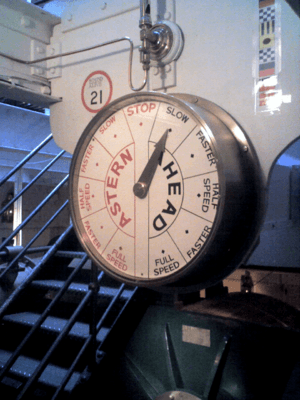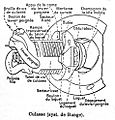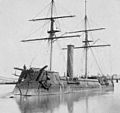Ironclad warship facts for kids

An ironclad was a powerful warship from the mid-1800s. These ships were special because they used steam power and were covered with thick iron or steel armor plates. They were created because older wooden warships could easily be destroyed by new explosive shells.
The very first ironclad battleship, Gloire, was launched by the French Navy in November 1859. The British Royal Navy also started building their own armored ships around the same time.
After the first battles involving ironclads happened in 1862 during the American Civil War, it became clear that these new armored ships were much stronger than the old wooden ones. Ironclads quickly became the most powerful warships in the world.
Ironclads were built for different jobs. Some were large battleships for open seas, others were for defending coasts, and some were long-distance cruisers. Ship design changed very quickly in the late 1800s. Ironclads evolved from wooden ships that used sails and steam to the all-steel battleships and cruisers we know from the 20th century. This happened because of bigger naval guns, better steam engines, and new ways to make steel.
Because things changed so fast, many ships became old-fashioned soon after they were built. Naval fighting styles were also constantly changing. Many ironclads were designed to use a naval ram (to crash into enemy ships) or torpedoes. The term ironclad stopped being used around the late 1890s, as new ships were simply called battleships or armored cruisers.
What is an Ironclad Warship?
Ironclads became possible and necessary because of new inventions in shipbuilding during the early 1800s. According to naval historian J. Richard Hill, an ironclad had three main features:
- A hull (the body of the ship) made of metal.
- Power from a steam engine.
- Main guns that could fire explosive shells.
All these important features were developed separately in the years before the first ironclads were built.
History of Ironclads
In 1592, Admiral Yi-Sun of Korea put armor plates on his "tortoise-ships." These plates protected the sides and top from bullets, arrows, and fire. This helped his small fleet win many battles against the Japanese fleet.
The first Western ironclad battleship, "Gloire," was launched by the French Navy in November 1859. The British Admiralty had been thinking about armored warships since 1856. They started building two iron-hulled armored frigates in early 1859. By 1861, they decided to build an entire fleet of armored ships.
After the first battles involving ironclads happened in 1862 during the American Civil War, it was clear that these new ships were the most powerful. They replaced the older, unarmored ship of the lines. Ironclads were very successful in the American Civil War.
By the 1870s, ironclads were the main warships for the world's strongest Navies. However, the ironclad era only lasted about 50 years. By the 1890s, most sailing ironclads had been replaced by modern battleships.
Images for kids
-
Napoléon (1850), the first steam battleship
-
A Paixhans naval shell gun. 1860 engraving.
-
French Navy ironclad floating battery Lave, 1854. This ironclad, along with Tonnante and Dévastation, defeated Russian land batteries at the Battle of Kinburn (1855).
-
HMS Warrior (1860), Britain's first seagoing ironclad warship
-
USS Cairo, an example of a City-class ironclad gunboat
-
Breech-loading 110-pounder Armstrong gun on HMS Warrior
-
The conventional broadside of 68-pounders on HMS Warrior of 1860
-
The iron-and-wood armor of Warrior
-
The Battle of Iquique, where Peruvian ironclad Huáscar sank the Chilean wooden corvette Esmeralda.
-
1904 illustration of H.G. Wells' December 1903 The Land Ironclads, showing huge armored land vehicles with Pedrail wheels.
See also
 In Spanish: Ironclad para niños
In Spanish: Ironclad para niños

























